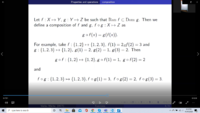Hello, everyone.
I need help with this, to understand what is going on in it.
I don't understand why a number is being assigned to the other number specifically, meaning for example: why is f(1)=2, and f(2)=3? Why can't f(1)=1 or f(2)=2?
(the same for the 'g' functions below it)
My question is if someone can please explain to me the reasoning behind the resulting outputs from the functions and what rules are guiding how it works.
Thank you very much!
I need help with this, to understand what is going on in it.
I don't understand why a number is being assigned to the other number specifically, meaning for example: why is f(1)=2, and f(2)=3? Why can't f(1)=1 or f(2)=2?
(the same for the 'g' functions below it)
My question is if someone can please explain to me the reasoning behind the resulting outputs from the functions and what rules are guiding how it works.
Thank you very much!

